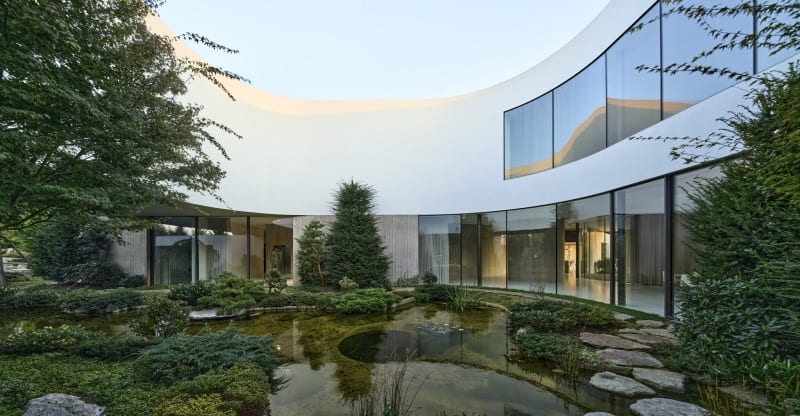A House from the Garden
 From the Garden House in Poland by KWK Promes is a house that trails a garden, its plan following the curves of the garden with nature tucking into the periphery of the house, even taking centre stage. A house that puts the focus back on nature through careful planning and reorganisation.
From the Garden House in Poland by KWK Promes is a house that trails a garden, its plan following the curves of the garden with nature tucking into the periphery of the house, even taking centre stage. A house that puts the focus back on nature through careful planning and reorganisation.
This project by KWK Promes had an unusual edge. The house came much later in the scope of things. The garden was the only focus, initially, for the clients, and the property was landscaped perfectly, celebrating nature at its finest. Everything seemed perfect in the setting, except that the house was missing.
And thus, the last facet of the property was brought to fruition by the Katowice-based architecture studio, who is no stranger to contemporary single-family residences, having won many awards for their innovative residences. Yet even with their extensive experience, their latest residential completion, a private villa in the Polish countryside, was an exceptional experience. The nature lover client has turned idle land into a beautiful green oasis with a lake and a smooth road to the place where the house was meant to be located, a place that was also assumed as an art gallery. The curved path, which the client enjoyed moving around, inspired the architect to begin his design process.
“The ground floor of the house forms a continuation of these curves and fits in softly with the surroundings. This impression is complemented by the grey concrete used on the facades, which refers to the colour of the existing, stone road, being the starting point of the project. The rounded form clearly separates the driveway from the rest of the garden, providing the residents with the intimacy and silence of the garden,” explains Robert Konieczny, the principal architect.
“Something that at first seemed to be a ridiculous reversal of the course of things, became absolutely logical when explained. The client wanted to be able to enjoy the garden to its full extent after the completion of the construction and moving in. Plants need much more time to reach their target size than it takes to build even such a large house. You might plant big trees after the process; however, it is costly and not environmentally friendly,” explains the architect.
“The ground floor is contrasted with the white minimalist flooring. Two different geometries clash, and an atrium links both the floors. The garden surrounding the house from almost all sides flows into its interior through the semi-atrium at ground floor level. We had only a minimal influence on the garden, so we treated it as a natural element that cannot be changed. Hence the name of the design, From the Garden House. Another important aspect was the investor’s wish to expose his rich art collections. Therefore, on the ground floor and the first floor, we created additional, large-size spaces designed exclusively for art exhibitions. The host can organise shows for a large number of people. Moreover, we placed the most important functions of the house within close proximity to each other to make it user-friendly,” says Robert.
The large shutters on the south and west elevations are not only of any formal importance. Finished with the same plaster as the walls, they close up the building in a uniform shape and protect valuable art collections from harmful sunlight.
“The aim to improve the quality of the surrounding space is atypical,” says the architect, “Due to the chaos of buildings and lack of vegetation, the client greens the vast areas of idle land surrounding him. He creates gardens, and then the construction of houses of different sizes follows up. We support him in creating green urban planning and providing friendly, sustainable space to live in, with plenty of greenery thus improving the quality of urban air.”
The entire housing estate, just like his house, use alternative sources of energy. The architects are all praise for their client who wishes to reimages spaces and thus reinvent the entire area into a green, friendly space for living not only for himself, but for the general public.
“Our client’s philosophy and actions are exemplary. Usually, the rich grab and privatise the most beautiful, unique green areas, often leading to irreversible degradation of the environment and landscape. Here we deal with the opposite process. Our client has reached for worthless idle land and turns it into a paradise that is shared. His actions resemble the reforestation of the space around the city. In our approach to the design of the house, we put emphasis on the order and tranquillity of the space, as the spatial chaos around the plot is a problem of distant suburbs. Our goal was to create a building, and in the future, more houses, which blend harmoniously into nature and, first and foremost, are objects that use alternative energy sources. What we focused on most in the design was to apply and develop sustainable systems. We wanted these houses, as well as the green areas that are being built with them, to continue to function as a single, self-sufficient organism in a changing climate.”
Having the garden as the starting point, KWM Promes created something that can be termed as “background architecture”, which functions in full symbiosis with nature, becoming part of the ecosystem. The house intertwines with the greenery, uses energy from the environment and its renewable sources, but also gives back to the environment. The architecture seems to live in full harmony with nature.
Details:
Collaboration: Michał Lisiński, Piotr Tokarski, Łukasz Marciniak
Construction: Kornel Szyndler PROECO
Investor: private
Useable floor area: 1500m2
Design: 2008-2011
Realisation: 2011-2021
Photograph: Jakub Certowic



















